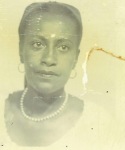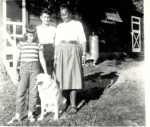I have been writing about ways I learned who I am, trying to write moments in the moment, without framing. I was hoping this way I would approach questions of race, gender, and class. These moments must be placed in context: the grid and grids of power within which I exist. An end question is: how can I in the moments of my life affect the force of that grid.
HOW DO WE KNOW WHO WE ARE?
I.
It was 1949 or so. We were going on a big adventure. We were going to live in Haiti for a year: my mother by birth, my mother by affection, my four year old sister, and I. It was Greenwich Village. Charity was the beloved music teacher at my elementary school. I was six. I had no idea what a big adventure it was. My mother, post-divorce from my father, taking her two little girls on an airplane to live in the West Indies. Two women, taking two little girls. Not a man in sight. A Jewish mother and her Jewish daughters. An African American woman, a music teacher with a degree from Juilliard. In 1949.
My mother took my little sister and me aside.
“Our plane with have to stop in Miami, on the way to Haiti,” she said. We stared back at her. We knew her. We knew there would be more. “Miami is in the south,” she said. We waited. She said, “In the south, Negroes are treated differently.” We did know about this category and that some people thought it important. Some people had egged our stoop and slashed the hood of our car because of Ethiopia. My sister and I knew about these things. “In Miami,” my mother went on, “when a Negro is walking down the street and a white person comes walking in the opposite direction, the Negro has to step down into the street.”
“Will Charity have to do that?”
“Yes. It’s wrong, but.”
“Couldn’t she just….” we wondered.
“No.”
“And what would we do?”
“We would walk in the street, too,” my mother said.
II.
Three of us in a women’s cell on the white side of the jail, Albany, Georgia, 1963.
A white man whose nickname was Mad Dog, was placed in the cell next to ours. “Freedom riding bitches,” he screamed, reaching his hand through his bars and angling it around and into our cell, so he could grope and grab.
The cop, white as they all were — one of the ones who had groped me when I was booked — came back and grinned. “Mad Dog is crazy. He don’t care about some —“ and he used the white southern expression for white people who don’t hate Black people —“Justice Department. He killed a man. Got off cause he’s mental.”
“Stupid bitches,” Mad Dog screamed, adding the epithet for white people who don’t hate Black people and he shook the bars. “Stupid freedom loving bitches. Oh, God, I hate you.” He vomited, thick and sweet, into the corridor. “Stupid, stupid, stupid bitches.” He shook the bars, his passion rocking the metal partition between him and us.
“I can’t take it,” he sobbed and threw his metal cup of water at the corridor’s single light bulb. It exploded and left us in darkness. I lay down as far from his side of the cell as I could.
Before dawn, to avoid a draft from the corridor, I switched to the bunk on his side. On my belly, I felt him shift on the other side of the wall. I couldn’t feel him breathe, but I could hear his breath catch in the back of his throat before he released it into the dark. He must be a big man, to crush his breath like that before it escaped. I slept, rocked when he shifted in his sleep.
III.
In 1988, I lived in West Virginia. Through my long-time friend Anne Braden, I’d become involved in the Rainbow Coalition and was doing advance work for Jesse Jackson’s visit to the Kentucky coal fields as a presidential hopeful. I was driving long days from Huntington on the Western edge of WV, crossing over the Ohio river and driving down the eastern edge of Kentucky to the coalfields, with their long, honorable, and bloody labor history. One dawn as I drove south in Kentucky beside a rock face, I passed a deer, running its heart out beside the road. As I kept up with traffic, it kept up with us, its black eyes bulging. Finally the deer dropped behind.
If you don’t know, I should tell you my friends Carl and Anne Braden had been attacked by HUAC* in the 1950s. The Bradens’ crime was that they, a white couple had, by pre-arrangement with a Black couple who were the Bradens’ friends, bought a house in a new “white” development and sold it to the Wades, the Black couple. Through the anti-Communist lenses of the time, this, obviously , revealed the Bradens alleged Communist sympathies. The 1950s visit to Kentucky by HUAC had been a riotous and hysterical circus. The Bradens, journalists, were fired by the Louisville newspaper, run by the so-called liberal Bingham family. Their name became infamous, particularly among Kentucky white people, and it also became synonymous with political bravery in certain circles.
I spent that day that I had overtaken the running deer at Jesse Jackson’s thrown-together headquarters. At the end of that day, as was often the case, I attended a night meeting in a coal-mining community. People sat in a circle on metal folding chairs, discussing the campaign and Jackson’s upcoming and unprecedented visit to Hazard, KY. At the end of the meeting, as I prepared for the long night drive home, a Black man in his 50s or 60s stopped me. He was heavy set, with the marked hands of a man who worked hard for his living. He wore a plaid wool jacket. We spoke about Rev. Jackson for a few minutes.
As he turned to go, he told me in weighted, low-voiced tones, “I been knowing the Bradens a long time.”
In those words, “I been knowing the Bradens…” I felt the coded message: that he was a man of a particular politics, that the Bradens’ infamy had not scared but had rather drawn him, and, to my flattered though exhausted mind, that he had recognized in me, a forty-something worn out remnant of the Civil Rights Movement, he had recognized that I was one of them, the people who had “.. been knowing the Bradens a long time.”
II. WHERE ARE WE IN THE MACHINERY OF THE WORLD?
June 2014
On my way into the Harm Free Zone meeting, I pass three young people playing Monopoly.
Inside, on one wall hang charts for Durham in 1937: the green zone where there are no “negroes” and no infiltration by “negroes,” where the white people who live there are prosperous professionals. The yellow and blue zones represent gradations on the way to the Red Zone, where “negroes” lived and whites did not. These are official government documents.
Standing there, looking at the charts, I feel naked. The house where I live with my partner falls squarely in the old Green (all “white”) zone. When house-hunting we had seen a couple of African American people entering and leaving houses on our block; as it turned out they were renters and within a year or two had moved out, laying bare the all-“white” nature of our neighborhood. If we had waited another year or two, we might have understood better where we were buying. If we had not just used our dollars, to settle like colonialists into our new territory, if we had learned our new community, we would have done things differently. What should we do differently, going forward?
In the meeting, we watch a film from California Newsreel, Race, the Power of an Illusion. It describes the U.S. government’s explicit and intentional use of government fiscal policies to maintain segregated and inferior housing for Black people. That the U.S. government and the U.S. banking industry, through the granting of loans to white people and the withholding of loans to Black people, were knowingly and intentionally complicit in maintaining racial oppression.
At the end of the film, two audience members joined the Monopoly game in the corridor. Later when they and the players joined us, all five described how, although the two late players were given the same size stake as the original three, by the time the two late comers joined the game, the early three had bought all the desirable properties. The early three described how, knowing the others would join them, they had conspired to lock out the newcomers. The late two described how they could barely scramble to stay off the properties belonging to the first three and lost their money paying fines.
I am the gradual accumulation of my personal identity — race, gender, class — but that exists within the grid of power. The film makes clear and as Michelle Alexander details in The New Jim Crow, how power has been used to willfully oppress and cause harm.
I believe a harm free world is possible, but it is only possible if we can force the grid to change.
* HUAC: House UnAmerican Activities Committee, primary agent of the U.S. government’s McCarthy era red-baiting and fear-mongering





